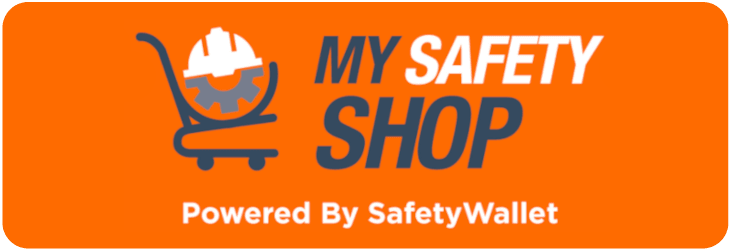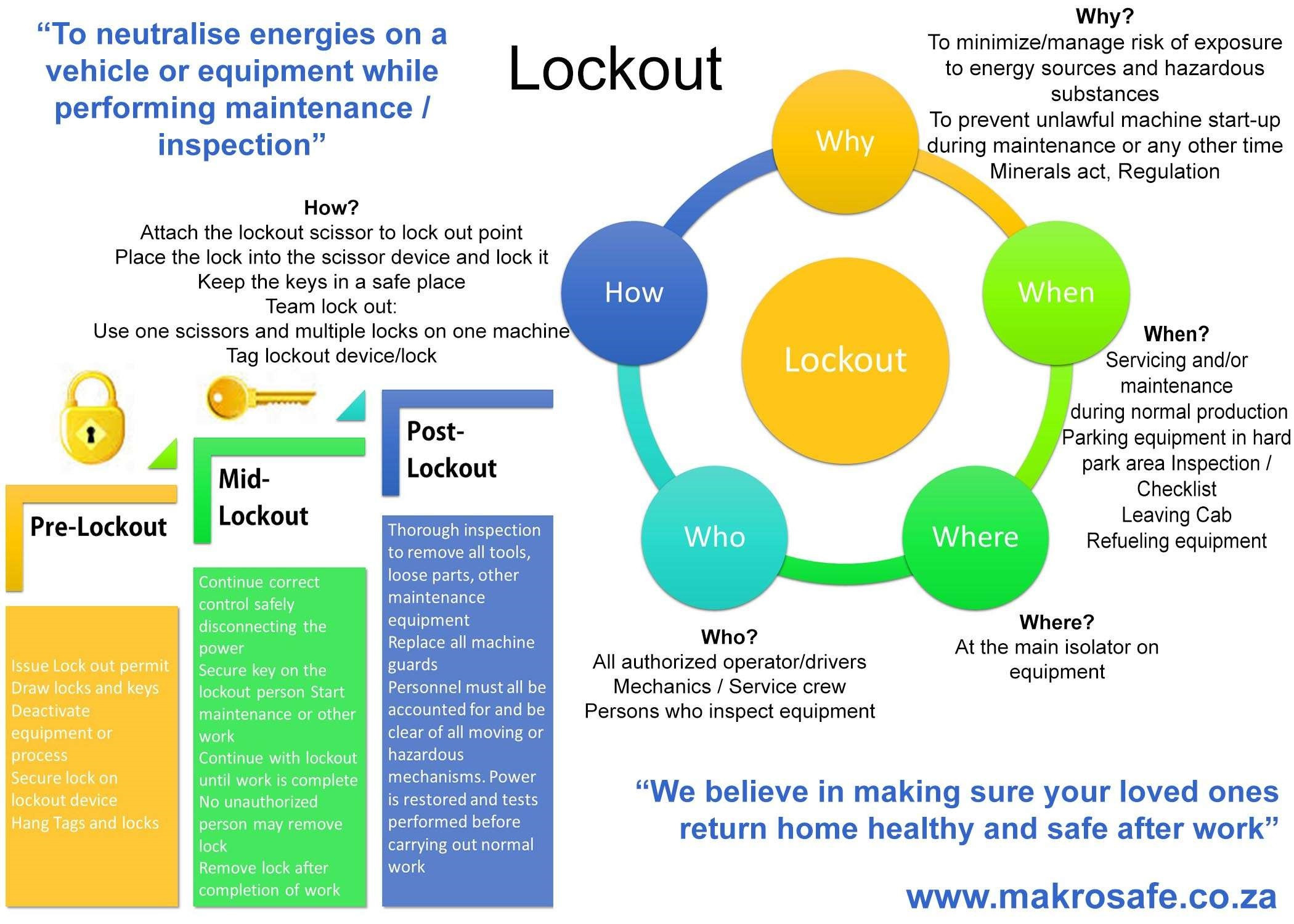How to conduct a lockout procedure
To “Lockout” means to neutralise all energies on a vehicle or equipment while performing maintenance/inspection. This is required for inspection on electrically powered equipment or machinery and also in the event of a break down, refuelling or while the vehicle remains in a parked area.
Steps for lockout
There are three basic steps for lock out procedures in the workplace:
Pre-lockout starts with the issue of a lockout work permit by the responsible person. This is followed by the drawing of locks and keys, deactivating the equipment or process through conventional or other means and the securing of the lock on the lockout device. This is accompanied by the completion and hanging of the tag on the lock. This tag will show who is working on the machine and the date on which the lockout was done. It also makes it easy to see if the lockout is currently in use.
Mid-lockout continues by ensuring that the correct control has been locked effectively disconnecting the power. Secure the key on the person who performed the lockout and start the maintenance or other work. This stage continues until all work is complete.
The removal of a lock by someone other than the one who placed it there should only be allowed under extreme circumstances, and then only with the express authority of the person who signed the permit, that is in the absence of the key holder. Once all activities are completed, get permission to remove the lock and tag and to restore the power supply.
Post-lockout begins with a thorough inspection to remove all tools, loose parts and other maintenance equipment. Replace all the machine guards and other guards. Personnel must all be accounted for and be clear of all moving or hazardous mechanisms. Power is then restored and the necessary tests carried out before resuming normal operation.
There are many types of potentially hazardous energy including, electrical, thermal, chemical, pneumatic, hydraulic, mechanical and gravitational energy. All such forms of energy must be locked out, blocked or released to ensure that machinery or equipment does not turn on or move during installation, repair or maintenance.
MAKROSAFE has been assisting clients for more than 23 years, they can assist you with all your Lock-Out Tag-Out needs, CONTACT US now.
MAKROSAFE / SAFETYWALLET and MY SAFETY SHOP are in Partnership.
Click on the image below to view / selet a SafetyWallet Subscription that suits your business: Why do we need to lock out?
Why do we need to lock out?
- To minimize / manage risk of exposure to energy sources and hazardous substances.
- To prevent unlawful machine start-up during maintenance or any other time.
- Minerals Act, Regulation .
When is it appropriate to use lockout?
- Servicing and/or maintenance during normal production.
- Parking equipment in hard park area.
- Break down.
- Inspection/checklist.
- Leaving cab.
- Refuelling equipment.
Who needs to lock out?
- All authorised operator/drivers.
- Mechanics / Service crew.
- Persons who inspect equipment.
Where to lock out?
At the main isolator on equipment.
How to lock out?
- Attach the scissors to the lock out point.
- Place the lock into the scissors and lock it.
- Keep the keys in a safe place.
- Team lock out.
- Use one scissors and multiple lock on one machine.
Application of lockout
Lockout and tag the energy-isolating device with an assigned, individual lock. A worker will not be protected unless he/she uses his/her own padlock.
If more than one worker is working on the same piece of equipment at the same time, each one should lock out the equipment, by placing a personal lock and tag on the group lockout device when he/she begins work, and should remove those devices when he/she stops working on the machine or equipment.
Locks and tags should clearly show the following:
- The name of the person who applied the device
- The date
- The reason for the lockout
This identifies who is servicing the machinery or equipment. In a multiple lockout/tagout situation, it will also identify any workers(s) who may not have finished working.
Locks and tags must be durable enough to withstand the environment in which they are to be used. Information on the locks and tags should remain legible.
Locks must be substantial enough to prevent removal without the use of excessive force. Tags must be substantial enough to prevent accidental or inadvertent removal.
Both locks and tags are to be standardised by colour, shape, or size. Tags should be easily recognised and provide appropriate information about the lockout.
For some equipment, it may be necessary to construct attachments to which locks can be applied. An example is a common hasp to cover an operating button.
Tags must be attached to the energy isolating device(s) and to the normal operating control in such a manner as to prevent operation during the lockout.
Verification of Isolation
After ensuring that no workers can be injured, operate the push button or other normal controls to verify that all energy sources have been disconnected and the equipment will not operate.
If there is a possibility of re-accumulation of stored energy, such as an increase in pressure to a hazardous level, isolation of the equipment must be periodically verified until the maintenance or repair is completed, or until the possibility of such accumulation no longer exists. Return operating controls to neutral position after the test.
A check of system activation such as using a voltmeter for electrical circuits, should be performed to ensure isolation. The equipment is now locked out.
How do you secure the isolation?
For work on low voltage electrical equipment or circuits, ensure that the correct point of isolation and lockout procedure is identified, an appropriate means of isolation is used and the supply cannot be inadvertently re-energised while the work is carried out.
A fundamental principle is that the point of isolation should be under the control of the person who is carrying out the work on the isolated conductors.
Tagging systems should also be used at the point(s) of isolation where possible for general information.
The isolation should be secured by locking off and tagging the electrical equipment as follows:
Instruction, information, training and supervision
Appropriate instruction, information, training and supervision must be provided to ensure that electrical equipment that has been de-energised to allow electrical work to be carried out is not inadvertently re-energised. This includes appropriate instruction, information and training on isolation procedures to everyone who may be affected at the workplace.
Locking off
Isolation points should be fitted with control mechanisms that prevent the electrical equipment from being inadvertently re-energised. The control mechanism should require a deliberate action to engage or disengage the device. It should be able to withstand conditions that could lead to the isolation failing, for example vibration.
This may include switches with a built-in lock and lockouts for switches, circuit breakers, fuses and safety lockout jaws (sometimes called ‘hasps’).
All circuit breakers, switches and combined fuse switch units should be locked off to secure the isolation where possible. Alternative controls may include an additional component. For example a clip, screw, bolt or pin that can be inserted to prevent a switch from being operated.
These types of controls should be used in conjunction with additional control measures, such as danger tags and permit systems.
If more than one person is working on the same de-energised electrical installation, individuals should ensure their own personal lock is applied to the isolation point, otherwise the principles of tagging apply, as listed below:
- No-one should operate an isolator or knowingly use equipment where the isolator has a control mechanism attached.
- In situations where isolation points are accessible by other persons at the workplace ensure, so far as is reasonably practicable, that the isolation method or system is not able to be inadvertently or easily compromised.
Subscribe to SafetyWallet and let OHS OnLine assist you with managing your Health and Safety program, click on the image below for more info:
Tagging systems
Danger tags
Isolation involves using suitable warning or safety signs as well as locks or other controls to secure the isolation.
Where possible, a tag should be attached to normal locks, at all points of isolation used to de-energise electrical equipment from its electricity supply.
A tag does not perform the isolation function.
Danger tags are not required when using dedicated personal isolation locks.
Danger tags are used for the duration of the electrical work to warn persons at the workplace that:
- The electrical equipment is isolated or out of service
- The electrical supply must not be switched back on or reconnected
- Reconnecting electricity may endanger that life of the electrical worker(s) working on
the equipment.
The danger tag should:
- Be durable and securely fixed to the isolator
- Clearly state the warning, including any warning about specific hazards relating to the isolation such as multiple points of supply
- Be dated and signed by the worker or workers involved in carrying out the work or, where appropriate, by the supervisor in charge of the workers
- Be attached in a prominent position on each isolation point i.e. the point or one of many points used to isolate electrical parts) or device
- Only be removed by the signatories to the tag.
If the work is incomplete, due to change of shift, the last person removes their danger tag or lock and replaces it with a warning tag such as an “out of service or caution”.
When work is resumed, the person in charge of the work removes the warning tag (out of service or caution) and each person then applies their danger tag and/or lock.
When work is finally completed, each person removes their danger tag and/or lock.
Where a formal permit system is used, all reasonable steps must be taken to ensure that the designated sign-on and tagging procedures are followed.
Out of service tags
Out of service or caution tags are used to identify electrical equipment that is not safe to use or fit for purpose. The out of service or caution tag should:
- Be durable and securely attached
- Clearly state the nature of the defect or reason why the electrical equipment is unsafe
- Be attached on a prominent position on each isolation point.
- Only be removed by a competent person after fixing or rectifying the defect and making the electrical equipment safe, or replacing with a danger tag in preparation to work on the equipment.
How to conduct a lockout procedure
22nd Jun
Posted date: 22nd Jun 2022
Latest News - Inspections - Health-&-Safety-Services - General Health and Safety - Risk Assessment - OHS Inspection Services - OHS Compliance Audit - OHS Risk Assessment 



Comments (5)
This will help me going forward as i was asked to work on electricty with little knowledge i have thanks for your article
2023-01-30 16:33:22This will help me going forward as i was asked to work on electricty with little knowledge i have thanks for your article
2023-01-30 16:33:26Yes
2022-08-02 12:06:19I personally like your post, you have shared good article. It will help me in great deal.
2022-12-27 05:31:40Ok there has been an injury an I was not the authorized workman as I signed on annexure B ,but as a result sappi hom engineer as open a charge against me for not double checking my authorized workman is this possible coz I can't find any law which states that
2023-01-18 09:38:54